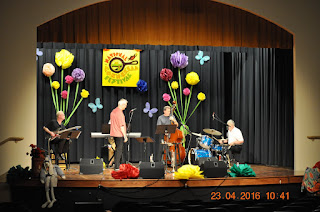I traveled to Huntsville for the Finding Huntsville Walking Tour with Carol Cordori.
I parked in front of Constitution Village and stopped at their public restroom after my long ride to Huntsville.
Meet up with a group of people at Harrison Brothers who were interested in the History of Huntsville.
We began our tour a little after 11 A.M., with guide Carol Cordori, after we were all given a 12-page Finding Huntsville Field Guide.
 |
| Harrison Brothers Bank Vault, where records were kept |
Building 1: Commercial Architecture of Harrison Brothers
Built in the 19th century with large glass display windows that had a recessed front door, long rows of transom windows above the display windows, and bricks that projected beyond the walls.
Building 2: First National Bank of Huntsville
Built about 1837- 1840 in the Greek Revival Style
Built with a pitched roof and a triangular front supported by Columns made up of a base, a shaft, and a capital.
Local builder George Steel drew up the plans for the bank.
 |
| Greek Revival "First National Bank of Huntsville" |
Building 3: The Madison County Courthouse was built in the International Style.
Built with a flat roof, tall columns supporting a large porch, and no attached decorations, it is often constructed of glass, steel, and concrete. Built in 1966 by Northington, Smith, Krannert & Associates, "Space Built"
Building 4: Romanesque Revival Schiffman building, built in 1845 and remodeled by George Thompson in 1895.
It has been owned by the Schiffman family for more than 100 years.
It was built of rush stone with carved leaves or flowers, bow windows, and a recessed front under an arch.
Building 5: Gothic Revival Style (used to teach Christianity). The Church of Nativity was built in 1859 by Wills and Dudley.
The trefoil represents the Trinity (God, Christ & Holy Spirit), and the quatrefoil represents the four Gospels: Matthew, Mark, Luke, and John.
The Lancet arches, tracery, and engaged buttress point up toward Heaven.
We were greeted by the Minister and given a tour of the temple.
 |
| Stained glass window notice at the top that the three-point clover represents the Trinity, and the bottom 4 points clover represents the Gospels of the Bible. |
 |
| Gothic Style Church of Nativity Notice the steeple and windows, all pointing toward Heaven. |
We finished our tour on the sunken sidewalk in front of the old J. C. Penny building on the Square.
I walked around Huntsville Square, taking pictures of the art.
 |
| Red Ball Art on Square |
 |
| Small Bull Art |
 |
| Space Art |
I shopped at Harrison Brothers Mercantile.
I stopped once again at the Constitution Village Public restroom.
I took a few pictures of the beautiful blooming mums in Constitution Park.
 |
| Mums at Constitution Village |
I walked to my car and tried to open the door, but it would not open. (Keyless Remote)
I had put my remote in my back pocket, but it was not there.
I walked back to the restroom, thinking I may have dropped them on the floor or even in the toilet.
The keys were not there! Before I retrace my steps, I walked to the Constitution Village Museum Store.
I ask if anyone has found a keyless remote
I was dreading telling Hubby I had lost my keyless remote
Someone had turned it in; God was looking out for me.
The young woman behind the counter began by telling me about her lost-key episode.
She said she cranked her car (Using the Keyless remote) but had to go back inside. She forgot her key, got in her car, and left. She stopped for gas, filled her car, and went to crank it, but it would not crank, for she had no key. She had to call her husband and tell him to bring her the keyless remote.
Sometimes, Technology is not so great!
In today's world, we get lost in the daily hustle and bustle.
I did some shopping at Kohles in Madison, looking for an Ugly doll for Ava Grace.
Stopped at Wendy's in Athens for a hot bowl of chili, a chocolate Frosty, and Coke.
Arrived at about 3:45 P.M. at the East Lauderdale Quilt Show at Rogersville United Methodist Church.
They were giving out awards and getting ready to close.
What a day! Walked in the drizzling rain, with the wind whipping around the buildings, while listening to our guide describe the art of five historic buildings in Huntsville.
The Minister of the Church of the Nativity took the group on a guided tour.
I had my picture taken with the group.
Lost my keyless remote in the Constitution Village Public Restroom.
Did a little shopping in Madison, ate a late lunch in Athens, and saw a quilt display in Rogersville. I was home around 4:30 P.M., a little before Hubby arrived home from work.



















































